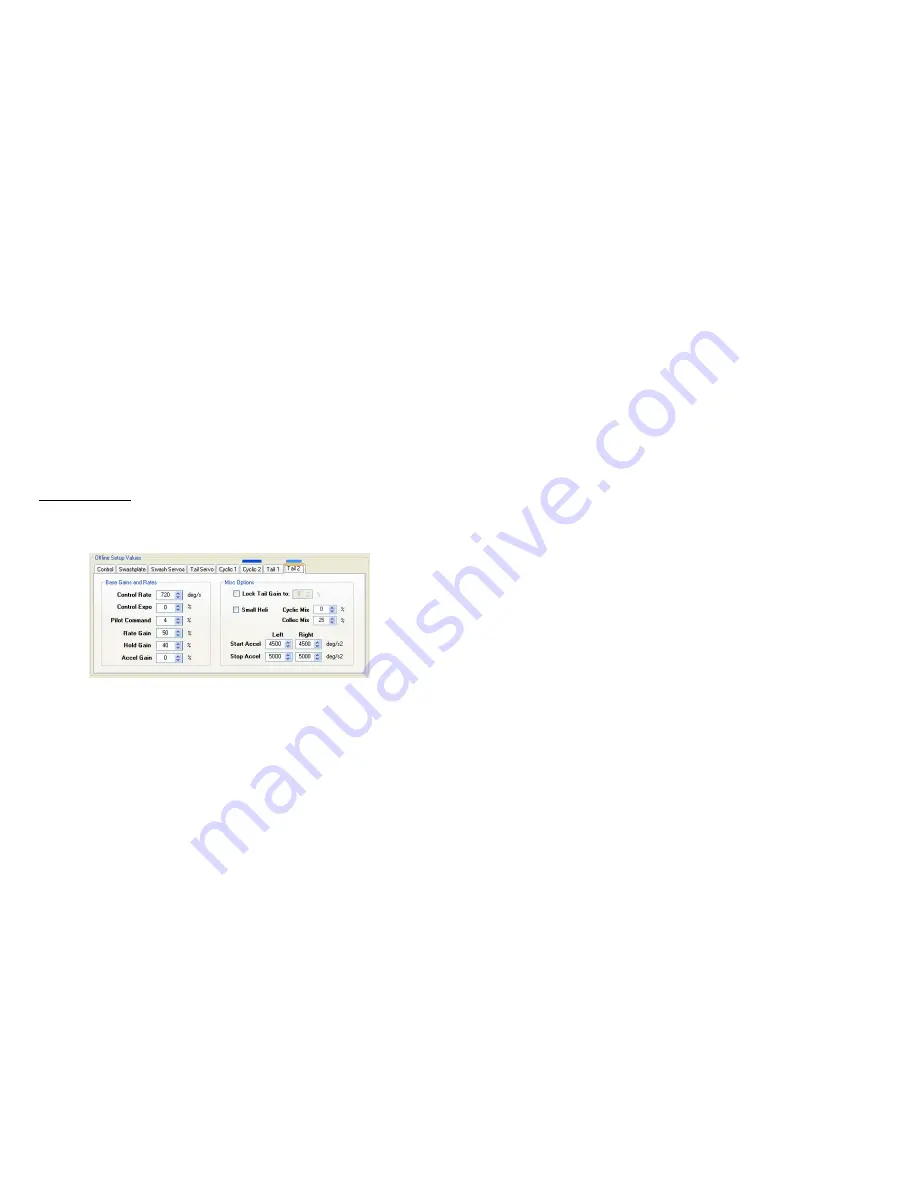
©2010 Skookum Robotics, Ltd
49
Hiller Decay:
Causes accumulated Hiller response to decay back to neutral, to
make the gyro more forgiving of perturbations. If you watch a helicopter
with a flybar in hover, you’ll see the flybar’s disk offset for a moment then
drift back to level after a sharp control input. This option provides the same
effect digitally.
A value of 100% here can help smooth out rapid tic-tocks, piros or other 3D
maneuvers, especially repeated ones. However, high values for Hiller Decay
will also limit the gyro’s ability to hold steady in gusty wind or trim the
helicopter precisely in hover.
Self-Leveling
:
Sets how strongly the helicopter tends to pull itself towards level
in elevator and aileron. Set the Self-Leveling value to a higher value (i.e.
75%) in one of the two Cyclic tabs to enable a “bail-out” switch. Activate the
bailout mode by switching to that bank.
Tail Tuning Tabs
The two
Tail
tabs are found in the
Offline Setup Values
region of the main SK720
setup software window as shown in Figure 19.7 below. The blue bar marks the
tab that is currently active. Switch the active tab using your transmitter.
Figure 19.7 – SK720 Setup Software
Tail
Tabs
Control Rate:
Sets the maximum allowable yaw rate of the helicopter at
maximum rudder stick deflection.
Expo:
Positive values make the rudder stick less sensitive near center-stick,
negative values make it more sensitive near center.
Rate Gain:
The response of the tail blades to the error in rate of motion. This is
the tail’s primary gain.
Hold Gain:
The response of the tail blades to accumulated tail position error.
This allows the gyro to trim the tail and compensate for wind. Set this value to
0% for rate mode. Set this value to about 60% for heading hold.
©2010 Skookum Robotics, Ltd
50
Accel Gain:
Response to acceleration error of the tail. Gives a sharper response
but is normally set low or to zero. This gain can wear the tail servo. Sometimes
helpful on smaller helis that feel “loose” near center.
Small Heli:
This option increases the response delay that the system expects the
tail servo to have. It is useful for helicopters 450 size and smaller.
Start Accel:
The maximum rate of starting acceleration of the tail, left or right. If
the value is too low, the helicopter will seem sluggish in yaw. If it’s too high, it
will tend to bounce even at low gains.
Stop Accel:
The maximum rate of stopping acceleration of the tail. Normally a
little bit higher than the start acceleration.
Cyclic to Tail:
Feeds in tail pitch to directly compensate for torque changes due
to changes in blade pitch due to cyclic (aileron and elevator). Normally 0% to
15%. Increase this value if the helicopter’s tail twitches to the right during flips.
Collec to Tail:
Feeds in tail pitch to directly compensate for torque changes due
to changes in collective pitch. Normally 15% to 30%. Increase this value if the
helicopter’s tail twitches to the right during climb outs.
Tail “Rate Mode” and “Heading Hold”:
Set the hold gain to 0% for rate mode.
Set the hold gain to about 60% for heading hold mode.


















